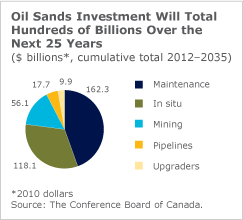Oil Sands Will Generate Economic Benefits in all Parts of Canada
 Nearly one-third of the economic benefits of oil sands investment between 2012 and 2035 will occur in provinces other than Alberta, according to a Conference Board of Canada report assessing the impact of an estimated $364 billion investment on Canada’s regions and industry sectors.
Nearly one-third of the economic benefits of oil sands investment between 2012 and 2035 will occur in provinces other than Alberta, according to a Conference Board of Canada report assessing the impact of an estimated $364 billion investment on Canada’s regions and industry sectors.Much of the economic benefits outside Alberta will be in Ontario and British Columbia.
In addition to the direct effects associated with spending on new projects, as well as spending on improvements, maintenance, and repairs to capital assets, this study considers supply chain effects - employment associated with the use of intermediate inputs or other support services that are part of oil sands investment.
The research also includes income effects, which occur when the wages that employees earn from the direct and supply chain effects are spent.
The study breaks this employment impact down as:
•direct effects in the construction industry of 880,000 person-years of employment;
•supply chain effects of 1.45 million person-years of employment in a variety of industries, but predominately in oilfield services, professional services, manufacturing, wholesale trade, financial services, and transportation; and
•income effects of 880,000 person-years of employment resulting from the spending of wages and salaries, estimated at $172 billion.
These figures include only the effects of investment; the production that would result from the investments would generate additional employment and supply chain effects.
 The majority of the supply chain employment effects (70 per cent) will occur in Alberta. The supply chain effects in Alberta are geared toward industries where oil and gas in general, and oil sands in particular, are a major source of revenues.
The majority of the supply chain employment effects (70 per cent) will occur in Alberta. The supply chain effects in Alberta are geared toward industries where oil and gas in general, and oil sands in particular, are a major source of revenues. Nevertheless, nearly one-third of supply chain effects will occur in other provinces, (broken out by share of the national total):
•Ontario (14.8 per cent): Above-average employment effects (compared to the province’s share of overall effects) will occur in services, but also in manufacturing inputs for the oil sands. Manufactured inputs account for one-fifth of the manufacturing employment effects.
•British Columbia (6.7 per cent): In the B.C. goods sector, miscellaneous plastic products (such as plastic building materials and plastic storage tanks), paper products, and wood products all experience outsized (above-average) effects. So do services like scientific services, legal and accounting services, computer services and transportation and travel-related industries.
•Quebec (3.9 per cent): supply chain effects are tied to the large businesses that are headquartered in Quebec, such as CGI for computer services and CN for rail transportation.
•Prairies (3.7 per cent): The Prairie region’s role as a transportation hub between Eastern and Western Canada is apparent - as rail and truck transportation experience outsized effects. Industries such as steel mills, metal tanks, steel pipes and tubes, printing, and medical equipment and supplies also gain from supply chain effects related to oil sands investment.
•Atlantic Canada (0.8 per cent): industries that have above-average effects include: ornamental and architectural metal products; construction machinery; navigational, measuring, medical, and control instruments; and tire manufacturing.
Beyond the employment impacts, oil sands-related investment is expected to generate government revenues of $79.4 billion ($45.3 billion in federal revenues and $34.1 for provinces) between 2012 and 2035, on an inflation-adjusted basis. This includes the effects of personal income taxes, corporate profit taxes, and indirect taxes (such as sales taxes and taxes on fuel).
The investment forecast is based on assumptions that oil sands resources will be developed under certain market conditions, but a number of factors could affect the level of investment over the next 25 years.
These include: capacity constraints in the oil sands region, the possibility for global oil supply or demand to behave differently than expected, and the need to mitigate risks associated with the environmental footprint of the oil sands.
The study was funded by the Government of Alberta and Industry Canada.
You can return to the main Market News page, or press the Back button on your browser.

